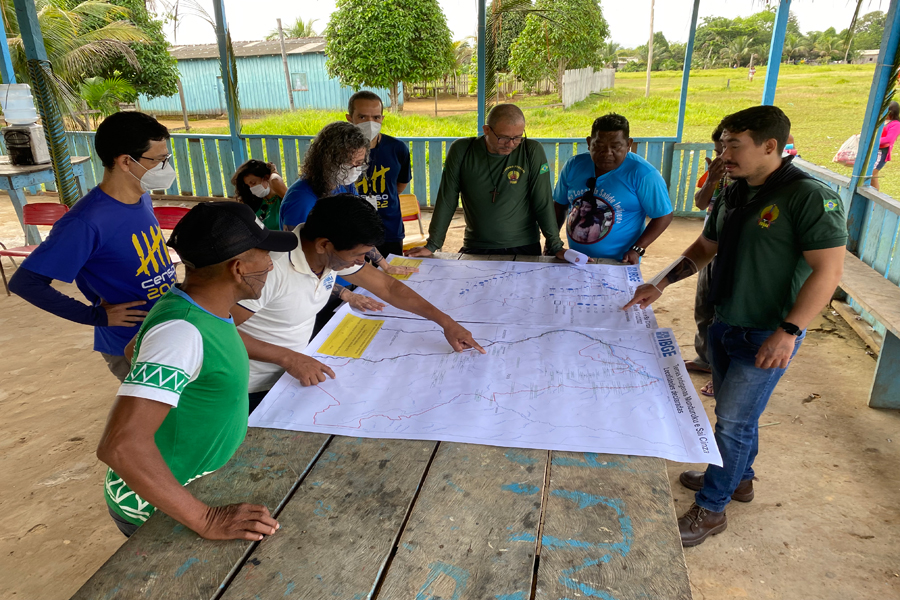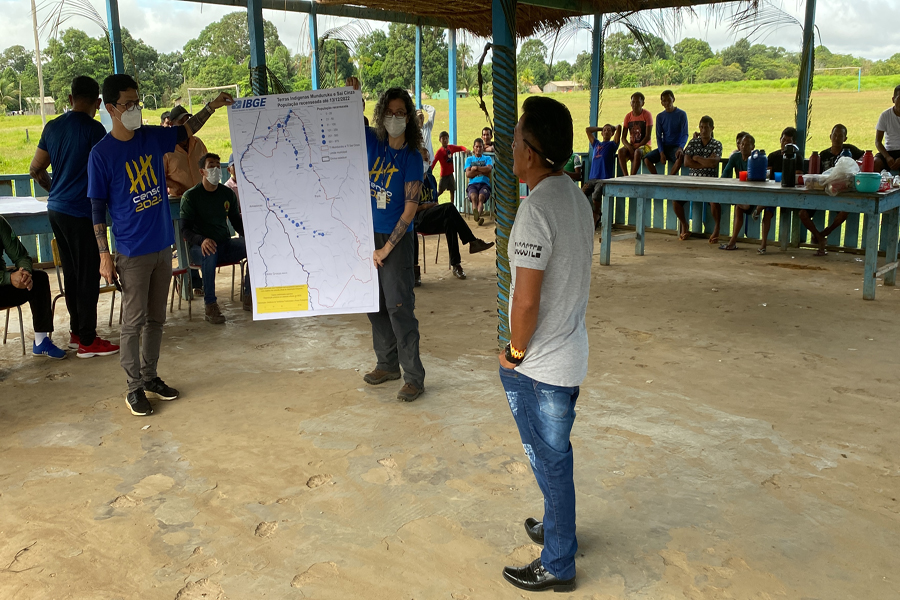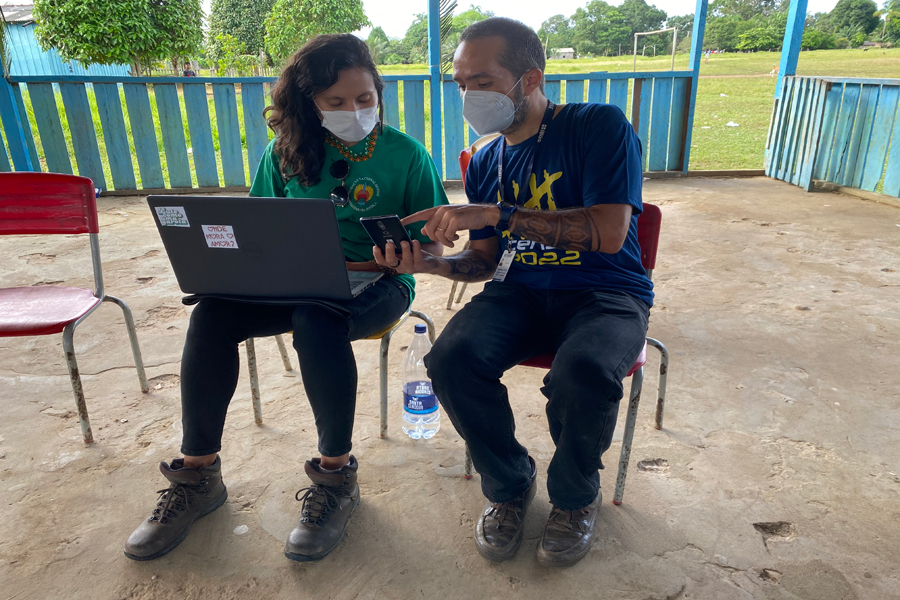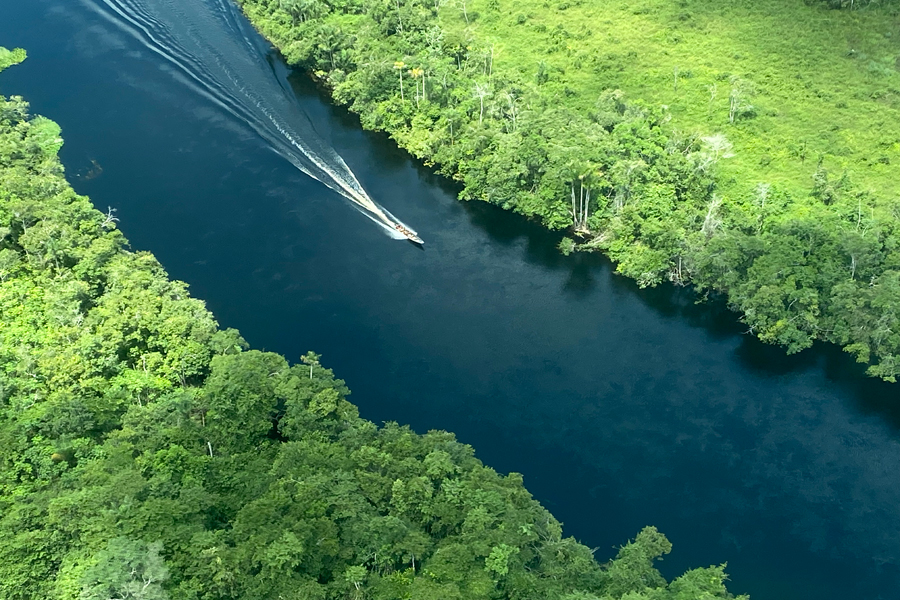IBGE finishes enumeration of Mundurukus - Pará's Indigenous population
January 31, 2023 16h31 | Last Updated: February 02, 2023 12h16

A team made of members of the state technical coordination of the Census at Pará and of the Work Group of Traditional Peoples and Communities was at Jacareacanga (PA), on December 18, to thank Indigenous leaders and communities of the Munduruku ethnicity for the support and participation throughout the data collection in the region.
The data collection in Jacareacanga was one of the biggest 2022 Census' challenges, due to the several accounts of difficulties reaching the Indigenous population, either because of communication barriers (as many Indigenous only communicate in their native language) or because of the long-distance trips to reach the villages.
To face those challenges, social scientist José Costa Jr., who works as a census analyst linked to the Work Group of Traditional Peoples and Communities, explains that several measures were taken, like the criation of an exclusive subarea for Jacareacanga; increase in the number of enumerators and supervisors for the region; as well as new partnerships with the Tapajós Regional Coordination, of FUNAI, and the Indigenous Special Sanitary District (DSEI) of the Tapajós River.
“Based on such initiatives and with partners' support, it has become possible to carry out awareness raising activities with Indigenous leaders in a series of meetings in the communities much before collection”, says the analyst.
Back in June 2022, presentations about the 2022 Census were made inside the Sai Cinza and Missão São Francisco villages. In the latter, the difficulties had been so great that the IBGE could not carry out the collection in the 2010 Census nor in the Census of Agriculture (2017).
 Welcome on arrival of the IBGE team at the site - Photo: Douglas Gomes de Oliveira/ IBGE Collection
Welcome on arrival of the IBGE team at the site - Photo: Douglas Gomes de Oliveira/ IBGE Collection Hard to reach village in the Amazon region of Pará - Photo: Douglas Gomes de Oliveira/IBGE Collection
Hard to reach village in the Amazon region of Pará - Photo: Douglas Gomes de Oliveira/IBGE Collection



 Aerial view shortly before landing in the village - Photo: Douglas Gomes de Oliveira/IBGE collection
Aerial view shortly before landing in the village - Photo: Douglas Gomes de Oliveira/IBGE collectionAccording to Ms. Marta Antunes, coordinator of the Census in Traditional Peoples and Communities, the methodology of the 2022 Census in Indigenous lands respects these peoples’ right to consultation. “That is why, in June, we took two days going up the Tapajós River and the Cururu River in a bass boat to reach the Missão village, where the Census had not been allowed in 2010 or in 2017. In the way, we stopped by the health units of Sesai, leaving our awareness-raising material and talking to many leaders.”, she recollects. “In December, with our feedback, we showed the maps of the visited areas, making sure no village was left out.”
For state technical coordinator of the Census, Mr. Luiz Cláudio Marins, the result of so much effort in those awareness-raising initiatives paid off as the Mundurukus had an active participation throughout the entire operation. “The Indigenous acted as enumerators, interpreters in the training sessions, guides and interpreters during the whole collection, boat riders, among other functions. As a result, they could understand the importance of the work, seeing themselves as a part of the process”, claims Mr. Martins.
Strengthening relations
To keep the positive relationship with the Mundurukus established during the 2022 census operation, a meeting was carried out at the end of collection, on December 18, inside the Missão de São Francisco village, one of the most important villages of the region. “We insisted on giving this feedback to the community and its leaders. It was a very special moment, an opportunity to thank the “caciques” (chiefs), “pajés” (shamans), Indigenous teachers and the population in general, who welcomed us and were side by side with us the whole time”, says state technical coordinator Luiz Cláudio Martins.
The feedback meeting was also attended by the following civil servan:ts Douglas Oliveira (GPS); José Maria Costa (Analista Censitário/CD2022 - UE PA) and Marta Antunes (GT-PCT/IBGE). From Funai, the following took part: ombudsman Rute Pacheco, the head of the Tapajós Regional Coordination, Martin Corrêa; and civil servant Nicholas dos Santos.
The IBGE and FUNAI teams arrived at the municipalities of Santarém and Itaituba, in the morning of December 17, getting to the village in the afternoon of the same day. They left right after the meeting, on the next day.
